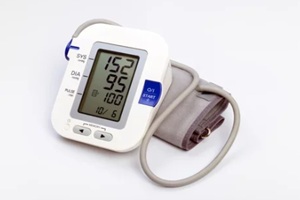 Managing hypertension without knowing your blood pressure is an exercise in futility. To paraphrase modern management’s so-called father, Peter Drucker, what gets measured gets managed.
Managing hypertension without knowing your blood pressure is an exercise in futility. To paraphrase modern management’s so-called father, Peter Drucker, what gets measured gets managed.
And this also applies to your blood pressure. Luckily, this doesn’t mean going to the doctor’s office every day to measure your blood pressure since you can do it at home. With home monitoring, you can track your numbers over time and provide useful data for your doctor.
This allows you to work together to calibrate medications, pinpoint lifestyle triggers, and take proactive steps to protect your health. Arm yourself with the right gear and techniques for accurate at-home readings.
Choosing a Validated Blood Pressure Monitor
The first step is getting an accurate home blood pressure monitor. The American Heart Association (AHA) and the American Medical Association (AMA) recommend using an automated upper arm cuff model instead of a wrist or finger device. Look for one that’s been independently validated for precision.
ValidateBP.org and StrideBP.org list monitors that have passed testing protocols. Features to compare include cuff sizes for different arm circumferences, adjustable inflation levels, data memory storage, downloadable readings, and battery options. Also, make sure to buy from a reputable medical supply company to avoid unpleasant surprises down the road.
Getting Set Up for Success
Proper positioning and a peaceful, distraction-free environment set the stage for reliable blood pressure checks. Have your healthcare provider calibrate your monitor yearly to ensure the numbers stay precise.
Follow the directions on the box (or in the instruction manual) to assemble your monitor. Place the cuff directly against your bare skin, about an inch above the elbow crease, centered over your brachial artery. Sit with feet flat and back supported. Rest the arm to be measured on a flat surface at heart level.
Make sure to limit caffeine, smoking, and strenuous activity 30 minutes before measuring, and also use the bathroom beforehand. Sit quietly for five minutes with proper posture before inflating the cuff. Remain still and don’t talk during the actual reading.
Take Proper Readings
 Take two back-to-back measurements using the same arm with a one-minute break between the two readings. Record the date, time, your recent activity level, the arm you used, and both complete numbers systolic/diastolic (i.e. 118/72 mm Hg). Also, make a note if you recently took any medications.
Take two back-to-back measurements using the same arm with a one-minute break between the two readings. Record the date, time, your recent activity level, the arm you used, and both complete numbers systolic/diastolic (i.e. 118/72 mm Hg). Also, make a note if you recently took any medications.
Repeat this schedule multiple times per day over a full week once every year to establish an accurate blood pressure range. Tracking as soon as you wake up in the morning and last thing before going to bed is particularly helpful. If your doctor advises daily monitoring over the long term, stick to once in the morning and evening.
Compare your at-home blood pressure to manual readings in your doctor’s office to ensure they align. If very different numbers emerge, recalibration or troubleshooting may be needed to guarantee data accuracy.
Analyze Patterns in Your Readings
Review your detailed logs to spot influencers on your blood pressure over time. Does it spike on stressful workdays? Does medication timing affect the numbers? Share the data with your doctor.
Tracking can uncover masked hypertension, where pressure reads normally in-office but runs higher elsewhere. It may also identify white coat syndrome if your blood pressure spikes only during visits. Discuss adjusting medications or trying lifestyle changes based on home readings.
Lifestyle Tweaks to Try
Certain daily habits can drive your blood pressure out of whack. Keep an open dialogue with your doctor about how adjustments may benefit your numbers without immediately adding medications.
Heart-healthy eating involves indulging in lots of fruits and vegetables, whole grains, plant proteins ( including beans and lentils), fish, skinless poultry, nuts, seeds, and healthy oils such as olive and avocado. Limit sweets, salty snacks, and saturated/trans fats. This diet is beneficial for your heart and might help you lose weight, which may also lower blood pressure.
The AHA advises adults to get at least 150 minutes per week of moderate-intensity physical activity such as fast walking. Also, include strength training, preferably at least twice a week. Not only will it help your cardiovascular system, but stronger muscles will do your overall well-being a world of good.
Good sleep is also important as that’s when the body recovers from the stresses of daily life. Therefore, try to get between 7 to 9 hours of quality sleep every night.
Stress is another big problem and is likely one of the biggest problems we all face in the modern world. That’s why managing stress through outlets such as therapy, meditation, socializing, journaling, yoga, or faith-based practices is important.
Finally, limiting alcohol and ditching cigarettes will also help. It might not be easy, but it does pay off in the long run.
Work With Imperial Center Family Medicine to Get Customized Hypertension Care
 Getting hypertension under control takes diligent tracking, lifestyle adjustments, open conversations with your doctor, and often prescription medications.
Getting hypertension under control takes diligent tracking, lifestyle adjustments, open conversations with your doctor, and often prescription medications.
Imperial Center Family Medicine in Durham, NC provides comprehensive cardiovascular care surrounding high blood pressure. Our team provides thorough guidance to help you make informed choices to manage your condition based on your unique health profile.
Contact us today at 919-873-4437 or through our website to learn more about our evidence-based blood pressure care programs. Our compassionate team aims to help each patient reach positive health goals through exceptional preventative medicine.
